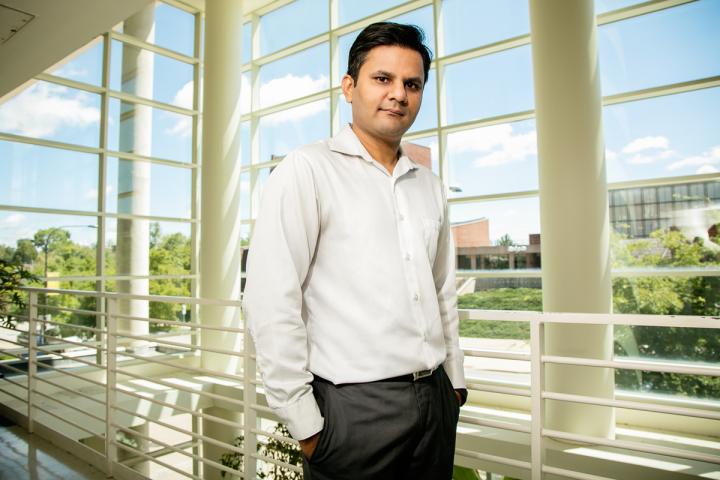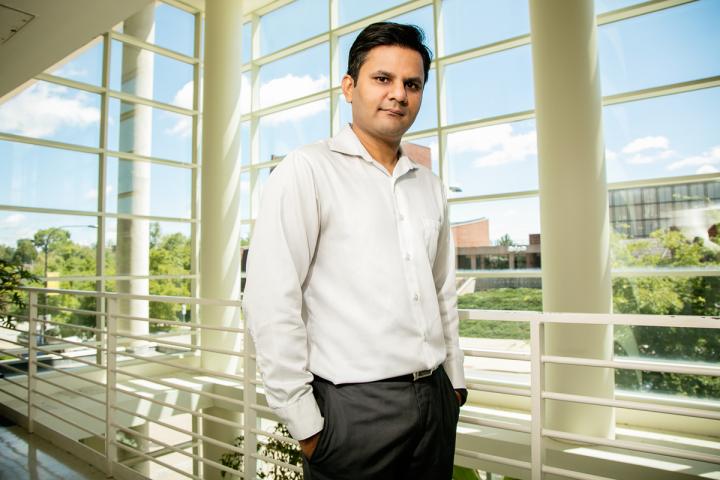
Credit: Photo by L. Brian Stauffer
CHAMPAIGN, Ill. — As devices become smaller and more powerful, they require faster, smaller, more stable batteries. University of Illinois chemists have developed a superionic solid that could be the basis of next-generation lithium-ion batteries.
Chemistry professor Prashant Jain and graduate students Sarah White and Progna Banerjee described the material – ultrasmall nanoclusters of copper selenide – in the journal Nature Communications.
"Now that we're seeing this nanoelectronics boom, we need tiny batteries that can be put on a chip, and that can't happen with liquid electrolytes," Jain said. "We are using nanostructured materials to achieve the properties at the heart of lithium-ion technology. They have much more thermal and mechanical stability, there are no leakage issues, and we can make extremely thin electrolyte layers so we can miniaturize batteries."
Standard lithium-ion and other ionic batteries are filled with a liquid electrolyte that the lithium ions move through. The ions flow one direction when the battery is being used, and the opposite direction when the battery is charged. However, liquid electrolytes have several drawbacks: They require volume, degrade as the battery cycles, leak and are highly flammable, which has led to explosions in phones, laptops and other devices. Though solid electrolytes are considerably more stable, ions move through them much more slowly, making them less efficient for battery applications.
The copper selenide nanocluster electrolyte combines the best of both liquid and solid electrolytes: It has the stability of a solid, but ions easily move through it like a liquid. Copper selenide is known to be superionic at high temperatures, but the tiny nanoclusters are the first demonstration of the material being superionic at room temperature.
The researchers discovered this superionic property by accident while investigating copper selenide's surface reactivity. They noticed that ultrasmall nanoclusters – about 2 nanometers in diameter – looked very different from larger copper selenide nanoparticles in an electron microscope.
"That was our first hint that they have different structures," Jain said. "We investigated further, and we realized that these small clusters are actually semiliquid at room temperature."
The reason for the semiliquid, superionic property is the special structure of the nanoclusters, Jain said. The much larger selenium ions form a crystal lattice, while the smaller copper ions move around them like a liquid. This crystal structure is a result of internal strain in the clusters.
"With around 100 atoms, these nanoclusters are right at the interface of molecules and nanoparticles," Jain said. "Right now, the big push is to make every nanoparticle in a sample exactly the same size and shape. It turns out with these clusters, every single cluster is exactly the same structure. Somehow, at this size, the electronic structure of the material is so stable that every single cluster has the same arrangement of atoms."
The researchers are working to incorporate the nanoclusters into a battery, measure the conductivity of lithium ions and compare the performance with existing solid-state electrolytes and liquid electrolytes.
###
The American Chemical Society Petroleum Research Fund supported this work.
Editor's notes: To contact Prashant Jain, call 217-333-3417; email: [email protected].
The paper "Liquid-like cationic sub-lattice in copper selenide clusters" is available online.
Media Contact
Liz Ahlberg Touchstone
[email protected]
217-244-1073
@NewsAtIllinois
http://www.illinois.edu
############
Story Source: Materials provided by Scienmag





